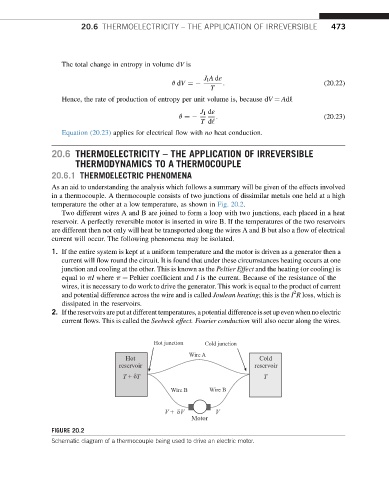Page 481 - Advanced thermodynamics for engineers
P. 481
20.6 THERMOELECTRICITY – THE APPLICATION OF IRREVERSIBLE 473
The total change in entropy in volume dV is
J I A dε
q dV ¼ : (20.22)
T
Hence, the rate of production of entropy per unit volume is, because dV ¼ Ad[
J I dε
q ¼ : (20.23)
T d‘
Equation (20.23) applies for electrical flow with no heat conduction.
20.6 THERMOELECTRICITY – THE APPLICATION OF IRREVERSIBLE
THERMODYNAMICS TO A THERMOCOUPLE
20.6.1 THERMOELECTRIC PHENOMENA
As an aid to understanding the analysis which follows a summary will be given of the effects involved
in a thermocouple. A thermocouple consists of two junctions of dissimilar metals one held at a high
temperature the other at a low temperature, as shown in Fig. 20.2.
Two different wires A and B are joined to form a loop with two junctions, each placed in a heat
reservoir. A perfectly reversible motor is inserted in wire B. If the temperatures of the two reservoirs
are different then not only will heat be transported along the wires A and B but also a flow of electrical
current will occur. The following phenomena may be isolated.
1. If the entire system is kept at a uniform temperature and the motor is driven as a generator then a
current will flow round the circuit. It is found that under these circumstances heating occurs at one
junction and cooling at the other. This is known as the Peltier Effect and the heating (or cooling) is
equal to pI where p ¼ Peltier coefficient and I is the current. Because of the resistance of the
wires, it is necessary to do work to drive the generator. This work is equal to the product of current
2
and potential difference across the wire and is called Joulean heating; this is the I R loss, which is
dissipated in the reservoirs.
2. Ifthe reservoirsare put atdifferenttemperatures, a potential difference isset upevenwhennoelectric
current flows. This is called the Seebeck effect. Fourier conduction will also occur along the wires.
Hot junction Cold junction
Wire A
Hot Cold
reservoir reservoir
T + T T
Wire B Wire B
V + V V
Motor
FIGURE 20.2
Schematic diagram of a thermocouple being used to drive an electric motor.

